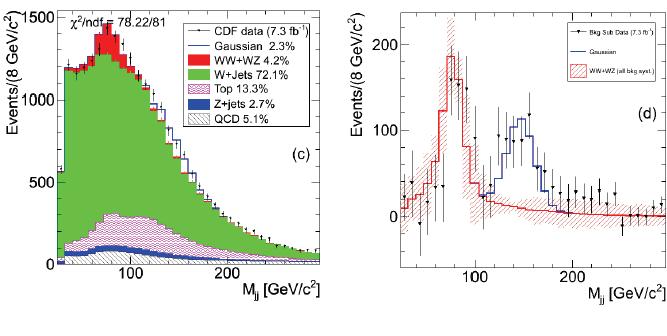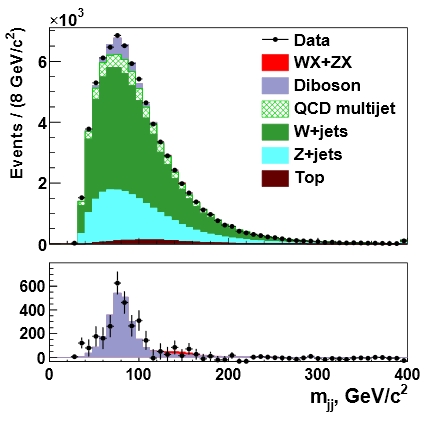The analysts had been searching for semileptonic WW pair production (that is, events where one W decays to a electron-neutrino or muon-neutrino pair, and the other decays to a quark-antiquark pair, thereby producing a dijet signature). As they studied the dijet mass distribution in search for the W->jj signal, in addition to that they observed a mis-modeling of the high-mass tail of the spectrum. A subsequent analysis targeting that region could not "explain away" the anomaly, while a resonant state could indeed fit well the data. The significance of the structure at 140 GeV was larger than three standard deviations in 4.3 inverse femtobarns of Run II proton-antiproton collisions at 1.96 TeV; once three more inverse femtobarns were added, it grew to well over four and a half standard deviations. A new technicolor particle?
The issue generated some controversy within and outside the experiment. Some in CDF felt that publishing that anomaly would damage the possibilities to claim a Higgs signal in the WH->lν bb final state, as the signature of the Higgs is not very different (although in that case these would be b-tagged jets). Others knew in their bones that such an effect could not be really due to a new resonance. Indeed, the past 30 years of history of collider physics show that the W+jets background is a tough one to handle. Its mismodeling in the eighties had led Rubbia to announce a top quark discovery later proven false, and others later on also fell in the same trap.
Several CDF collaborators would have preferred to wait and try to better understand the origin of the observed effect, i.e. whether a detector-related deformation or a shortcoming of the Monte Carlo simulation of the W+jets background could generate it. The researchers charged with the internal review of the analysis tried to do so for a few months but did not succeed; however, they ended up having a clear feeling that the time scale for resolving the issue would have been of one or two years. The CDF spokespersons decided that two years was too much time to wait, and after some additional checks and a careful wording, the paper describing the find was published in 2011.
Below you can see the kind of signal that was apparent in 2011 CDF data, in the 7.3/fb dataset that had been analyzed until then. The left figure shows the dijet mass distribution, the right one shows the background-subtracted data, with overlaid the diboson contribution in red and the potential new signal in blue. Indeed ,the structure at 140 GeV is quite suggestive !

After 2011 the effort to understand the origin of the anomaly at 140 GeV continued; as I reported in this blog some time ago, an explanation of the effect only came after it was understood that two competing effects are at work; one is the behaviour of QCD background in the electron channel, the other is the jet energy scale correction applied to jets which are originated from quarks or gluons, which in W+jets events populate different energy ranges.
In the meantime, other analyses studying semi-leptonic diboson production in complementary datasets also produced results. Two days ago finally CDF sent to the Cornell arxiv a very nice new search for that process, which also aims at verifying whether a bump is visible in the 140 GeV region where the previous analysis saw the excess. This search involves the signature of a Z boson decaying to two neutrinos (W bosons also contribute, since they also often yield a neutrino in their decay), accompanied by two jets which can sometimes be due to the hadronic decay of a W or Z boson. Of course, it is very hard to construct a model of new physics where a new particle couples to W bosons and not to Z bosons: so any new state showing up with a W should show up with a Z, too.
The abstract of the paper explicitly says that the analysis both targeted a measurement of dibosons and a verification of the absence of new physics:
We report on a search for a dijet resonance in events with only two or three jets and large imbalance in the total event transverse momentum. This search is sensitive to the possible production of a new particle in association with a W or Z boson, where the boson decays leptonically with one or more neutrinos in the final state. We use the full data set collected by the CDF II detector at the Tevatron collider at a proton-antiproton center-of-mass energy of 1.96 TeV. These data correspond to an integrated luminosity of 9.1 inverse femtobarns.
We study the invariant mass distribution of the two jets with highest transverse energy. We find good agreement between data and standard model background expectations and measure the combined cross section for WW, WZ, and ZZ production to be 13.8+3.0−2.7pb. No significant anomalies are observed in the mass spectrum and 95% credibility level upper limits are set on the production rates of a potential new particle in association with a W or Z boson.
The paper is a very interesting read, and I will not spoil you the fun of reading it by yourself. I will just show below the result of fitting the mass distribution of jet pairs in selected data by allowing a new resonance at 140 GeV to contribute. There is indeed very little space for such a process in CDF data featuring missing transverse energy and jets.
 In the graph you see two histograms. The top panel shows the dijet mass distribution of CDF data (black points) compared to the sum of the various background components. In blue is the diboson signal that CDF measured with the analysis. In the bottom panel you see the data once the contribution of all processes except dibosons. In red is shown the contribution allowed by the data of a possible WX/ZX signal. If you compare this with the towering diboson signal, you see that the missing ET plus dijet CDF data tells a wholly different story of the sample that first gave the hint that some new particle could be hiding at 140 GeV.
In the graph you see two histograms. The top panel shows the dijet mass distribution of CDF data (black points) compared to the sum of the various background components. In blue is the diboson signal that CDF measured with the analysis. In the bottom panel you see the data once the contribution of all processes except dibosons. In red is shown the contribution allowed by the data of a possible WX/ZX signal. If you compare this with the towering diboson signal, you see that the missing ET plus dijet CDF data tells a wholly different story of the sample that first gave the hint that some new particle could be hiding at 140 GeV.This, of course, is not the full end of the saga - a full-dataset analysis of the dataset where the 140 GeV bump was first reported with 4.3 inverse femtobarns is still due. But I am confident that we will soon get to read that paper, too.



Comments